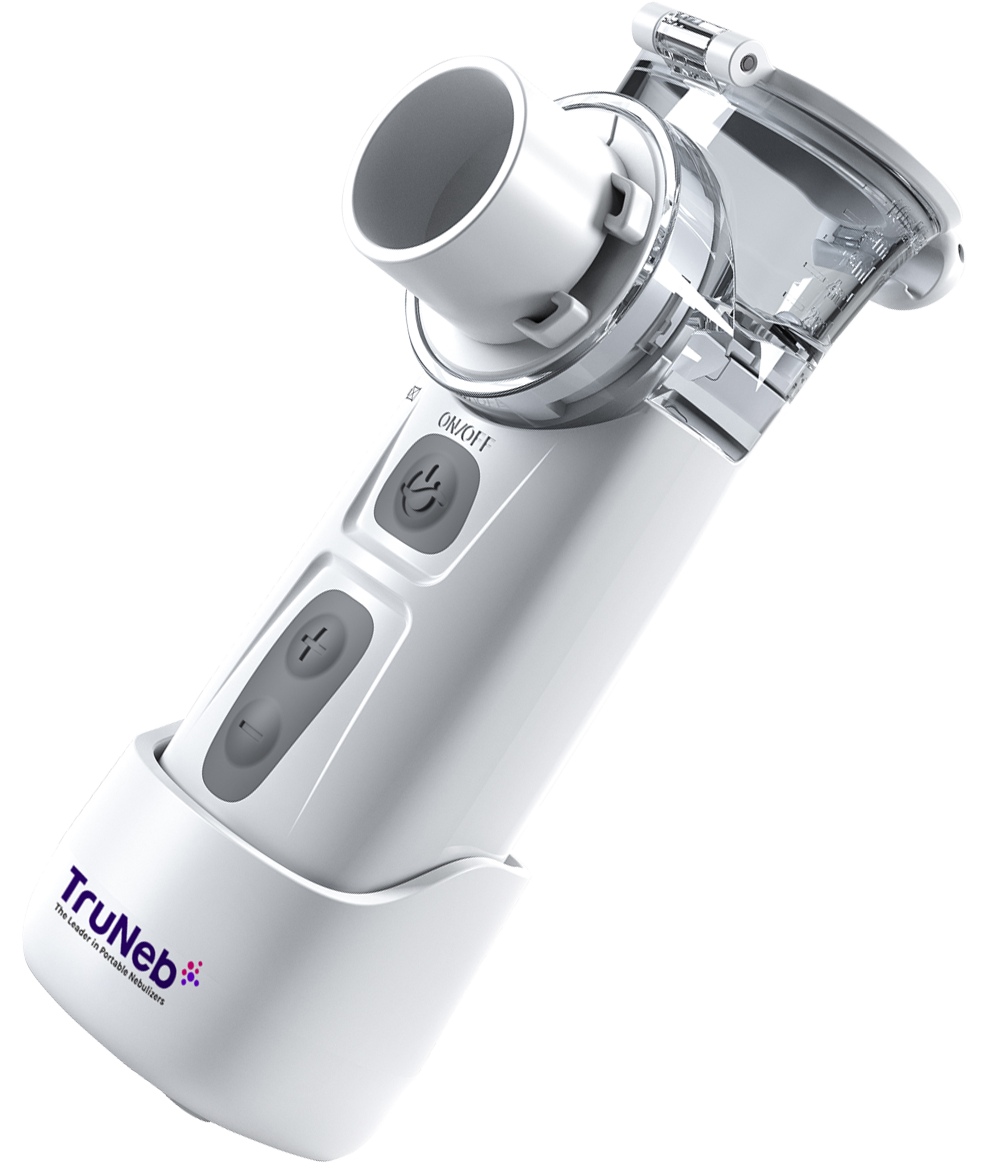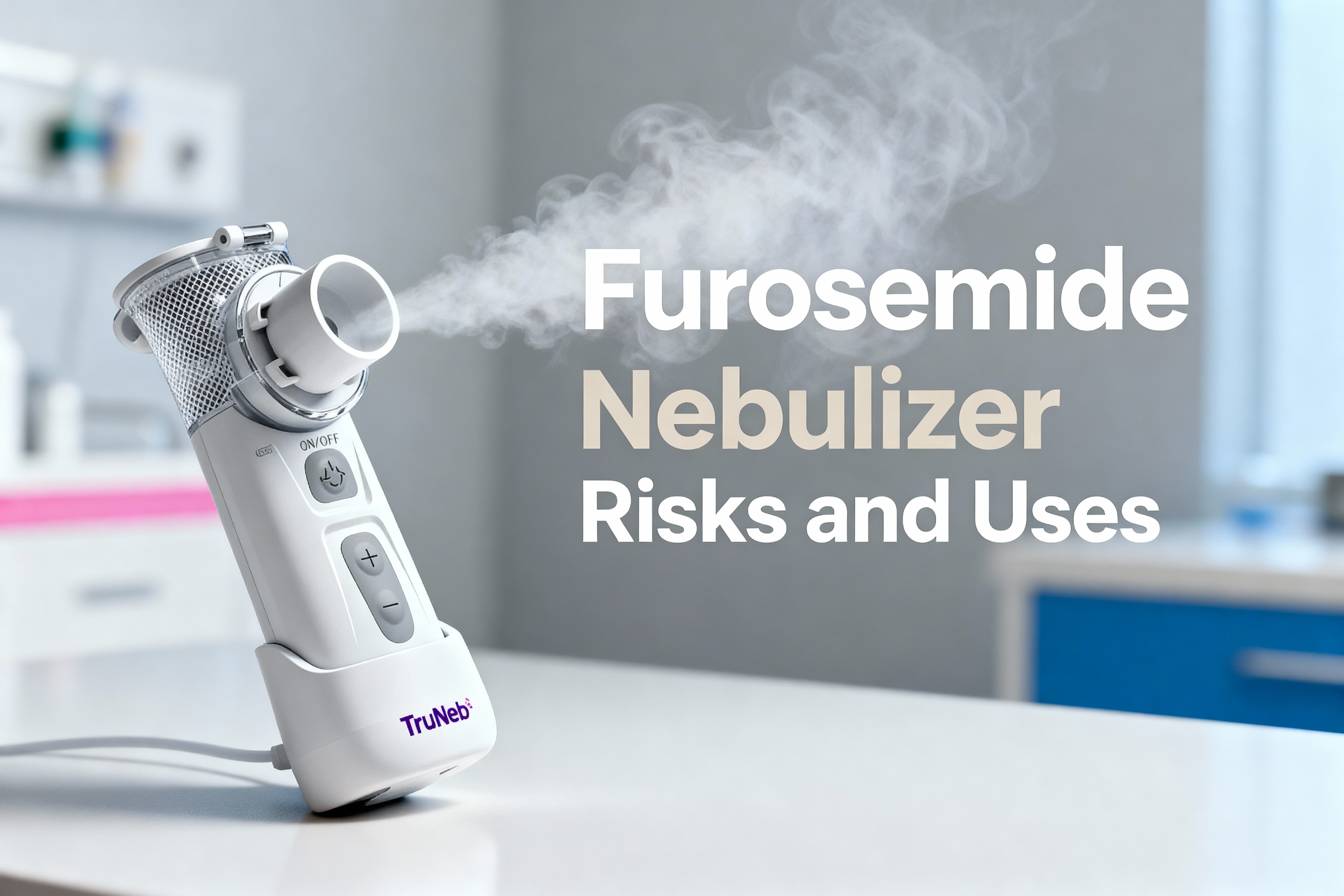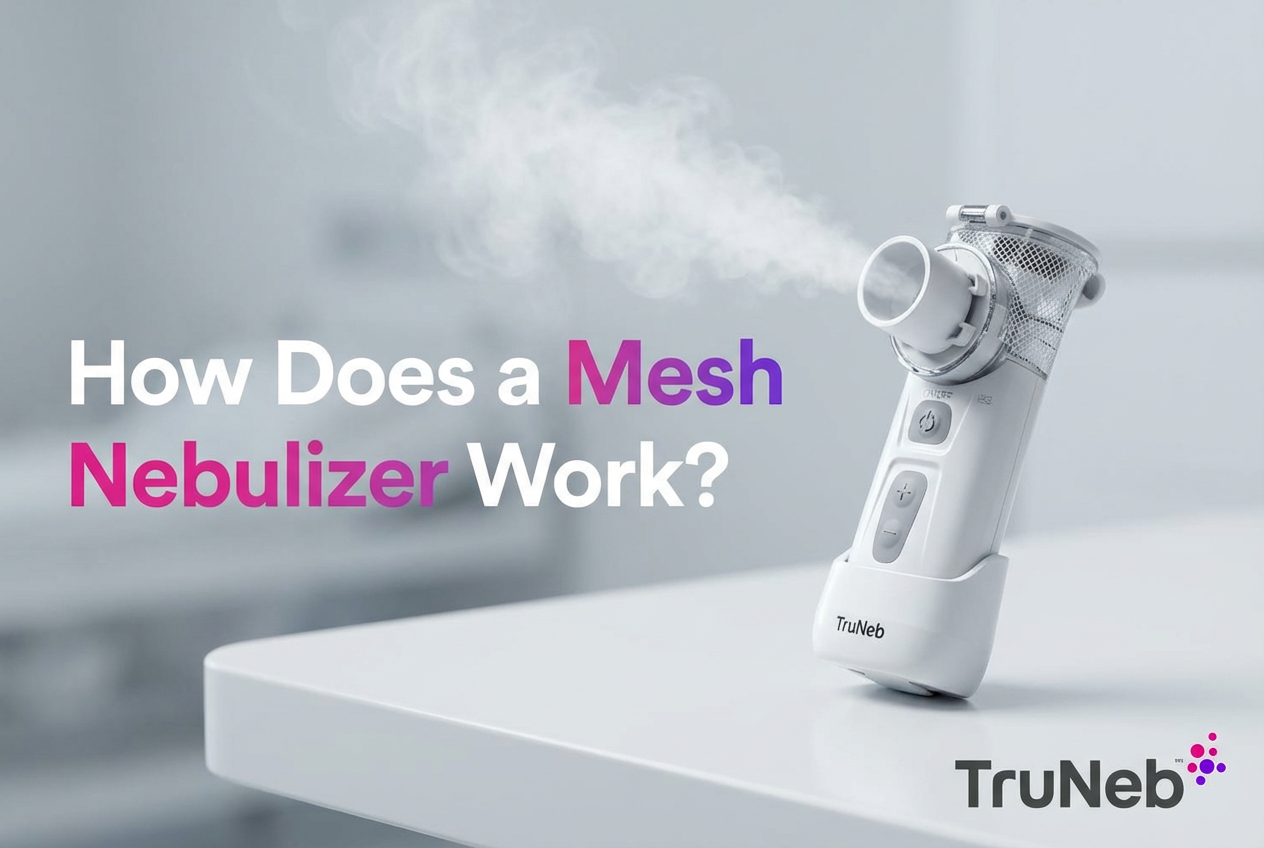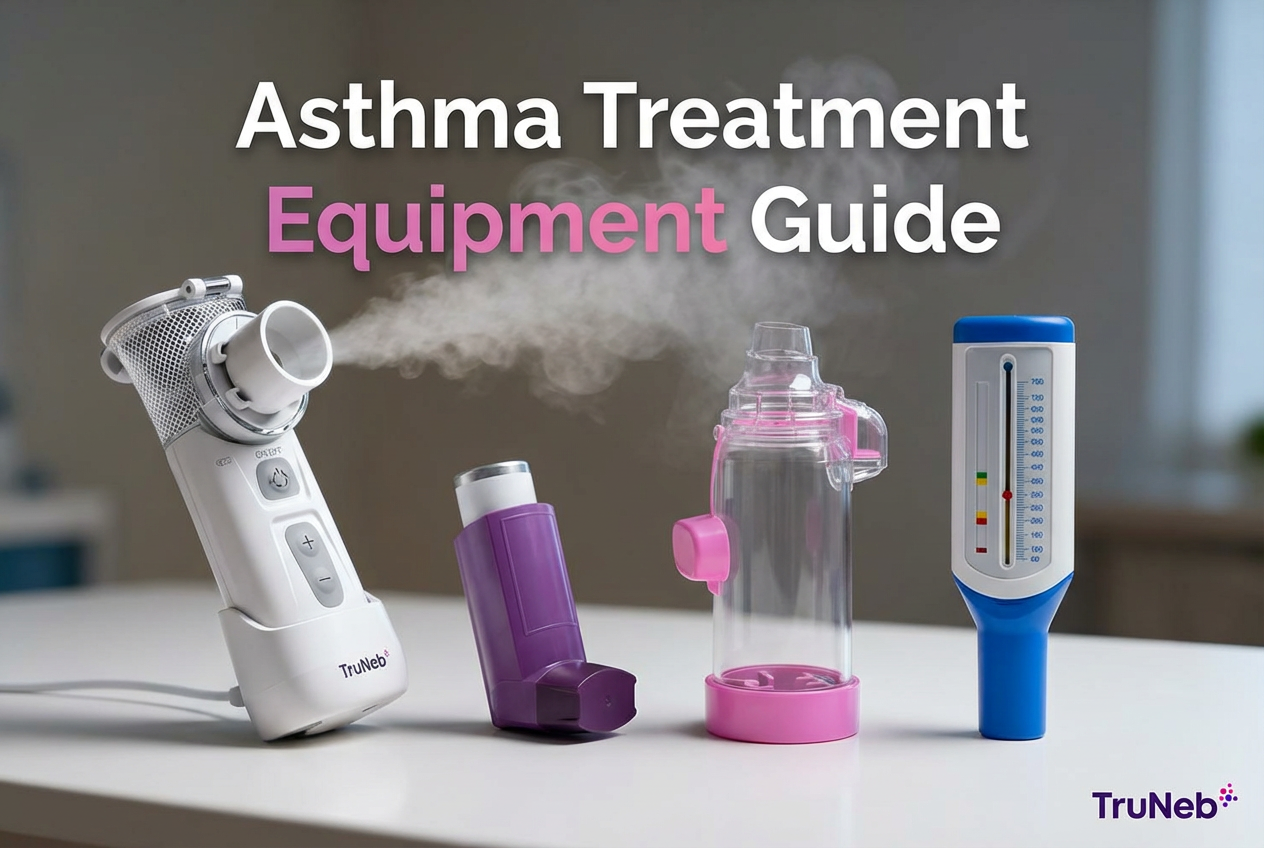On this page
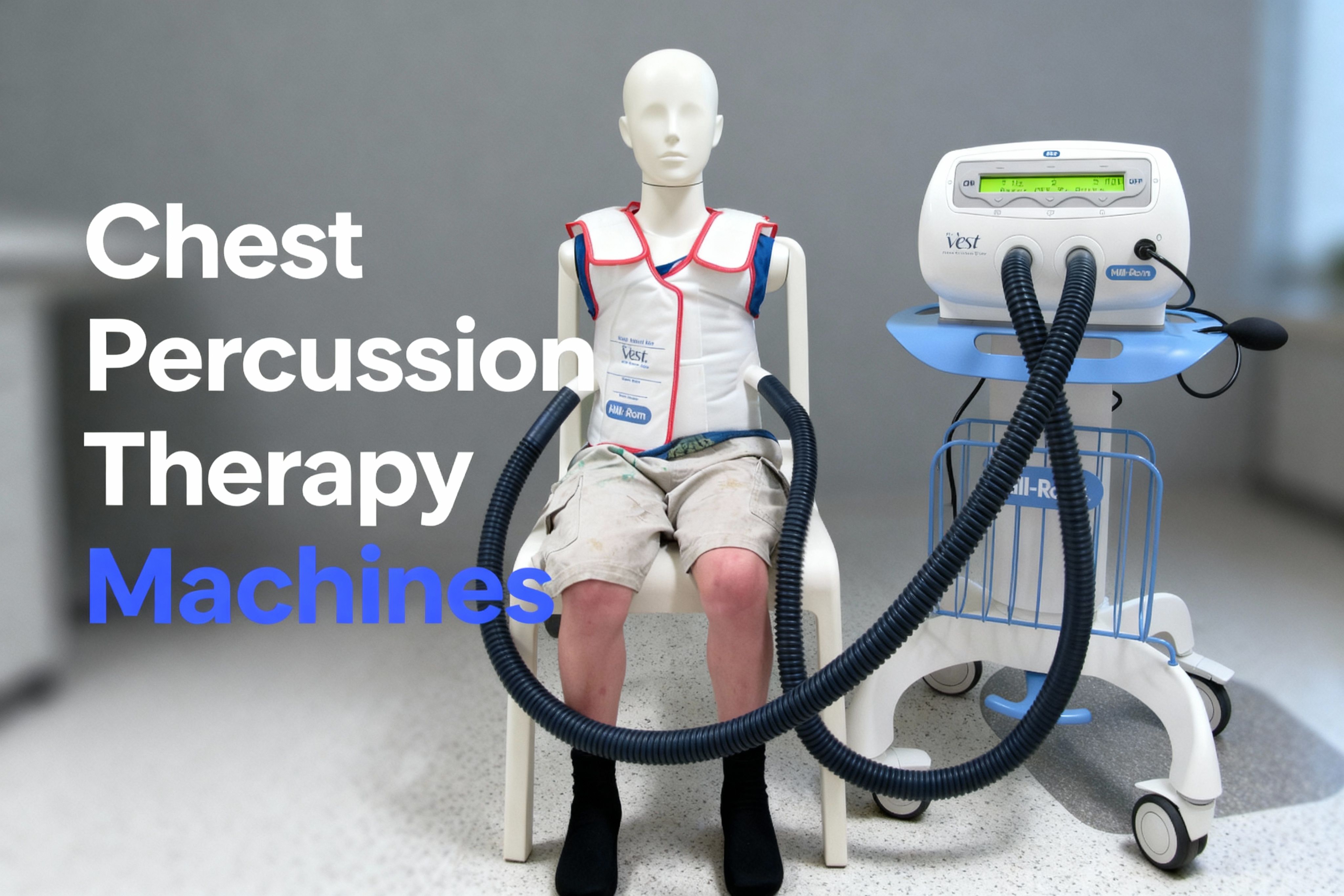
Disclaimer: This article is for informational purposes only and isn’t a substitute for professional medical advice, diagnosis, or treatment. Always talk with your doctor about your symptoms and treatment options before starting or changing any therapy.
What Is a Chest Percussion Therapy Machine?
A chest percussion therapy machine helps loosen thick mucus in your lungs so you can cough it out before it turns into an infection or makes breathing harder.
These machines are most commonly prescribed for chronic lung diseases like cystic fibrosis, bronchiectasis, and some forms of COPD where mucus tends to build up.
It does the same job as traditional chest physiotherapy (CPT), where someone claps on your chest and back, but it uses steady vibrations or gentle mechanical taps instead of hands. The Cleveland Clinic describes chest physiotherapy as using clapping, vibration, and certain body positions to move mucus from the smaller airways toward the larger ones so it can be cleared more easily (Cleveland Clinic).
You might hear these machines called airway clearance therapy machines, airway clearance devices, chest physiotherapy machines, percussion vests, or mechanical percussors. All of them are designed to help your lungs get rid of mucus when coughing by itself is not enough.
Key takeaway: A chest percussion therapy machine is simply a device that vibrates or gently thumps your chest to help clear mucus when your lungs need extra support.
High-Frequency Chest Wall Oscillation (Vest Therapy)
High-frequency chest wall oscillation (HFCWO) vests are one of the most common chest percussion therapy machines used for cystic fibrosis and bronchiectasis.
An HFCWO vest is a soft vest that wraps around your chest and connects to a small machine with flexible hoses. When you turn it on, the machine rapidly inflates and deflates the vest, creating fast, gentle squeezes and vibrations on your chest wall. Respiratory therapists often describe these vibrations as a series of small coughs that loosen and move mucus so you can cough or huff it out (Respiratory Research).
Vest therapy is one of several airway clearance techniques your care team might recommend, alongside positive expiratory pressure (PEP) devices or manual chest physiotherapy.
How a Vest Therapy Session Typically Works
A vest session, as taught by most care teams, usually looks something like this:
- You put on the vest and connect it to the machine.
- The machine inflates and deflates the vest for a few minutes at the settings your team picked.
- You pause to do huff coughs, spit out mucus, then restart the vest.
- These cycles continue for a total of about 20 to 30 minutes, once or twice a day, based on your treatment plan.
There are several vest brands, including The Vest by Hillrom, SmartVest, InCourage, and AffloVest. Each has its own features, but they all use high-frequency chest wall oscillation to help clear mucus.
Common upsides are that vests allow hands-free treatments and give very consistent percussion. Common downsides are cost, noise with older compressor units, and the squeezing feeling, which not everyone tolerates.
Key takeaway: An HFCWO vest uses rapid, gentle chest squeezes to shake loose mucus during short daily sessions so you can cough it out more easily.
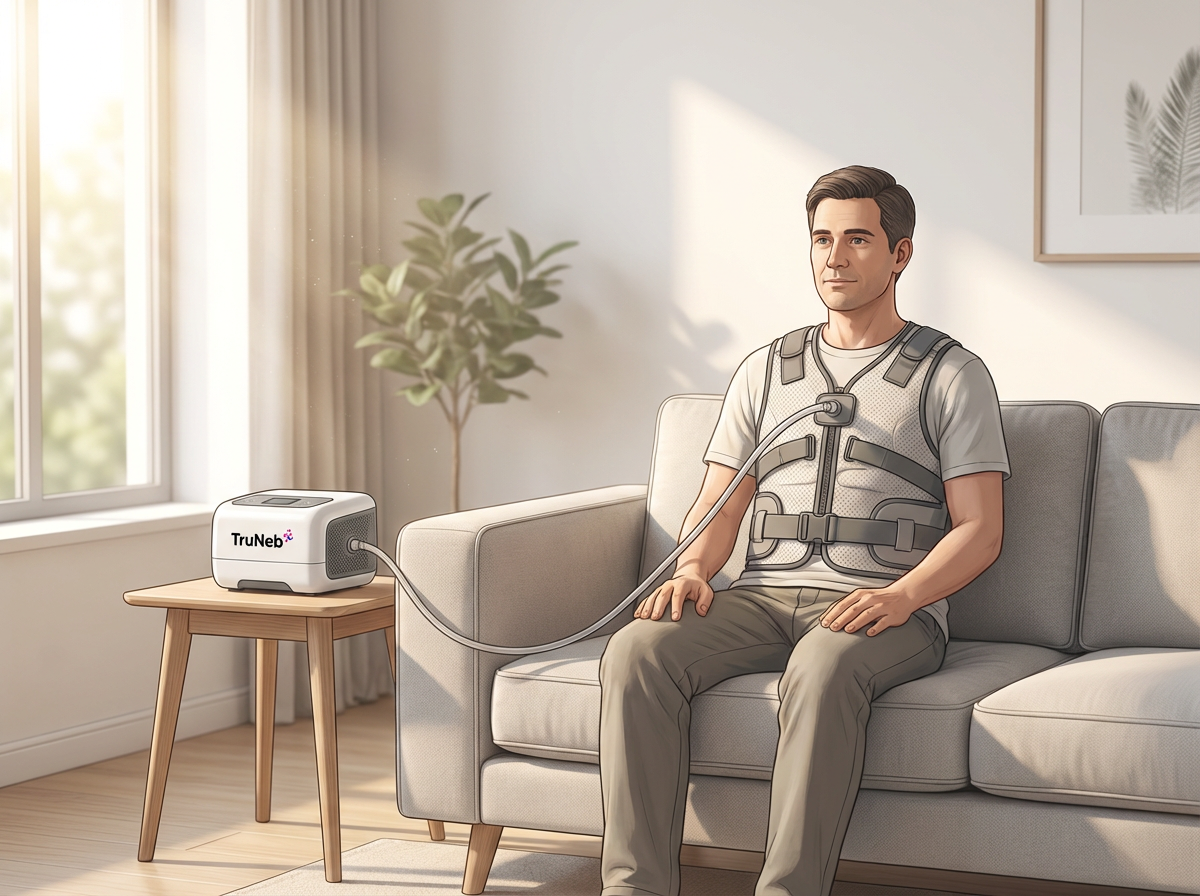
Handheld Percussors and Chest PT Devices
Handheld mechanical percussors are another type of chest percussion therapy machine. They’re commonly used by respiratory therapists in hospitals and can also be used at home.
These devices look a bit like a heavy-duty massage tool. A small motor drives a padded head that taps or vibrates against your chest when someone holds it in place. In hospitals, G5 percussors are widely used for chest physical therapy, and home versions like the G5 Vibracare are available for personal use (G5).
Other devices, such as the Electro Flo 5000, are built to replace manual chest percussion by delivering strong, rhythmic taps over all areas of the torso, sometimes with a strap that allows certain patients to treat themselves (MedSystems).
Sessions with a handheld percussor usually involve lying or sitting in specific postural drainage positions while a caregiver slowly moves the device over the upper and lower parts of the lungs. The tapping helps loosen mucus so coughing and breathing exercises can move it up.
A respiratory therapist or physiotherapist should show you the right positions and pressure so handheld treatments stay safe and comfortable.
Pros of handheld percussors include targeted treatment to certain lung areas and less fatigue for caregivers compared with clapping by hand. Cons include needing another person for most people, extra noise or vibration, and less frequent insurance coverage.
Key takeaway: Handheld percussors use a small motorized head to copy the clapping of manual chest PT, giving steady taps that help free mucus from your lungs.
Who Benefits From Chest Percussion Therapy Machines?
Chest percussion therapy machines are typically used by people who have long-term problems with thick mucus or trouble coughing it out on their own.
Groups that commonly use these airway clearance devices include:
- Cystic fibrosis (CF). Daily airway clearance is a core part of CF care to help protect lung function and prevent infections, and many people use a vest or other airway clearance device along with breathing exercises and nebulizer treatments (Cystic Fibrosis New Zealand).
- Non-CF bronchiectasis. Damaged, widened airways can trap mucus. Vests, percussors, and positive expiratory pressure (PEP) devices (such as Flutter, Acapella, or Aerobika) can help move mucus out and can reduce flare-ups for some people when used as part of a broader care plan. People might hear this described as using a percussion vest for bronchiectasis.
- COPD with chronic bronchitis. Some people with COPD make a lot of mucus and get repeated chest infections. Their pulmonologist can add airway clearance techniques or devices to their plan if standard inhalers and medicines aren’t enough.
- Neuromuscular conditions. People with muscular dystrophy, ALS, spinal cord injuries, or cerebral palsy tend to have weak coughs. HFCWO vests have been used in these groups to help manage secretions and lower the risk of pneumonia (Respiratory study).
- Primary ciliary dyskinesia and similar disorders. When the tiny hairs (cilia) that move mucus out of the lungs don’t work well, mucus can build up. Doctors sometimes prescribe airway clearance devices for people with primary ciliary dyskinesia or related problems to help move mucus.
- Post–lung transplant and certain asthma cases. For some people who have had a lung transplant or have asthma with mucus retention, transplant or asthma specialists may add airway clearance therapy to help manage secretions as part of a closely monitored plan.
Your age matters less than your lung health and your ability to cough. A pulmonologist or respiratory therapist can look at your history of infections, lung tests, and scans, then decide if a device should be part of your plan.
Key takeaway: Chest percussion therapy machines are usually prescribed for people with chronic mucus-producing lung or neuromuscular diseases when simple coughing and basic breathing exercises aren’t enough.
Using Nebulizer Therapy With Chest PT
Nebulizer treatments and chest physiotherapy can work better together than either one alone.
A nebulizer turns liquid medicine into a fine mist that you breathe in. Doctors commonly prescribe bronchodilators, like albuterol, to open the airways, and hypertonic saline (such as 3% or 7% solutions prescribed by your doctor) to pull water into thick mucus so it becomes easier to move. A review on hypertonic saline found that timing the nebulizer dose around airway clearance can improve how well mucus is cleared from the lungs (PubMed).
Your care team might suggest a routine like this:
- Nebulize a bronchodilator and/or hypertonic saline.
- Use your vest, handheld percussor, or other chest PT method.
- Do huff coughing or strong coughs to bring mucus up.
- Take any follow-up nebulized medicines, such as inhaled antibiotics, if they’re prescribed for you.
Always follow the exact sequence and medications your doctor gives you; don’t change timing or doses on your own.
A portable mesh nebulizer makes this routine easier to fit into daily life. The TruNeb™ portable mesh nebulizer is a small, handheld device that uses vibrating mesh technology to create an ultra-fine mist and runs quietly without a bulky compressor (TruNeb). You don’t need a prescription to buy the TruNeb nebulizer, but you still need prescriptions for most medications you use in it.
Some people also use nebulized hypertonic saline as part of airway clearance for thick mucus. You can read more about how hypertonic saline works in our bronchiolitis guide (TruNeb blog).
You might see boxes labeled “steam inhaler”—these are not for breathing prescription medications and they’re not the same as a nebulizer. Use only a nebulizer that’s made for medicine and approved by your doctor.
Talk to your doctor before trying a new medication, changing your dose, or changing when you use your nebulizer or vest.
Key takeaway: Using a nebulizer before chest PT can open and hydrate your airways so vest or percussion treatments move mucus more effectively.
How to Choose the Right Airway Clearance Device
So far, research hasn’t shown that one airway clearance technique is clearly better for everyone. A review of a mobile high-frequency chest wall oscillation (HFCWO) system found that its results were comparable to more traditional airway clearance methods when people used them regularly (Respiratory Research).
A large cystic fibrosis trial even found more infections and slightly faster decline in lung function in the vest group compared with people using positive expiratory pressure (PEP) techniques (Cystic Fibrosis New Zealand). This was one big study in cystic fibrosis, so your own results and preferences can be different.
That’s why most care teams focus on fit and routine instead of chasing one “best” device. Key questions to discuss with your doctor or respiratory therapist include:
- Can I use this method on my own, or do I always need a helper?
- Will I realistically have time and energy to use it every day?
- Do I travel a lot or need something portable and quiet?
- Does my insurance cover the device that makes the most sense for my diagnosis?
- How will I clean and care for it so it stays safe to use?
If you travel a lot, you’ll probably want something portable and quiet; if you usually need help with treatments, a method that a caregiver can manage comfortably might matter more.
Organizations such as Cystic Fibrosis New Zealand note that HFCWO vests are expensive pieces of equipment but are often covered by insurance or public funding programs for people who qualify. Handheld percussors and PEP or oscillating PEP devices (such as Flutter, Acapella, or Aerobika) typically cost less up front but aren’t always funded in the same way.
Summary: different airway clearance devices work similarly in studies, so the best choice is the one you and your care team can fit into your life and coverage.
| Device type | Can you use it alone? | Portability | Typical cost/coverage* | Good to know |
|---|---|---|---|---|
| HFCWO vest | Usually yes, after training | Bulky; home units stay in one place, some systems are more mobile | High cost; usually prescription with insurance or public funding for people who qualify | Gives consistent, hands-free treatments but can feel tight and be noisy. |
| Handheld percussor | Needs a helper for most people | Small machine that can be moved room to room | Moderate cost; coverage varies and home units aren’t always funded | Lets a caregiver target specific lung areas but adds noise and vibration. |
| PEP / oscillating PEP device (Flutter, Acapella, Aerobika) | Yes, once you learn the breathing technique | Very portable; fits in a pocket or bag | Lower cost; some models are bought out of pocket | Uses resistance and vibrations during exhalation to move mucus; needs coaching to learn good technique. |
| Manual CPT (hand clapping) | Usually needs a caregiver | No machine required | Low equipment cost; can still involve therapist visits | Can be effective but tiring for the person doing the clapping and depends on their technique. |
*Costs and coverage vary by country, insurer, and diagnosis. Ask your own care team and equipment supplier what applies to you.
A portable mesh nebulizer like TruNeb can fit alongside whatever airway clearance device you and your team choose, helping you get medication into your lungs before and after treatments.
Key takeaway: Since most techniques work about the same in studies, the “right” airway clearance device is the one that fits your body, lifestyle, and coverage so you can use it day after day.
Chest Percussion Therapy Machine FAQs
Tap or click a question below to see the answer:
For most devices, yes. High-frequency chest wall oscillation vests and a lot of mechanical airway clearance machines are prescription medical equipment. A doctor, usually a pulmonologist, needs to evaluate you and write an order so a durable medical equipment company can supply the device.
Manufacturers of mobile HFCWO vests, such as AffloVest, also require a doctor's prescription. Smaller tools, like oscillating PEP devices, can sometimes be sold without a prescription, but you should still get training from your doctor or respiratory therapist on how to use them.
A lot of insurers, including Medicare and Medicaid in some countries, cover high-frequency chest wall oscillation vests for people who meet certain criteria, such as having cystic fibrosis or bronchiectasis with repeated infections.
Cystic Fibrosis New Zealand reports that vest systems are very expensive if paid for privately but can be funded for some patients through health systems or charities. Always check with your insurance plan and the supplier before starting, and ask about any trials, rentals, or assistance programs that could lower your costs.
Not across the board. A large cystic fibrosis study comparing a high-frequency chest wall oscillation vest with positive expiratory pressure (PEP) found no better long-term lung function with the vest; the vest group actually had more respiratory infections and slightly worse lung function decline (Cystic Fibrosis New Zealand).
A broader review of oscillating devices also concluded that, when people use them regularly, different airway clearance methods perform similarly overall (Respiratory Research). For a lot of patients, the method they like and can stick with ends up working best.
Most people use chest percussion therapy machines safely, but some side effects can happen. You might feel sore in your muscles or ribs when you first start, or tired from extra coughing.
If you have very fragile bones, recent chest surgery, coughing up blood, or serious heart problems, your doctor needs to help choose the right device and settings for you. Stop a session and call your care team if you have sharp pain, dizziness, worsening shortness of breath, or coughing up more blood.
If your breathing suddenly gets much worse, you have severe chest pain, or you cough up a lot of blood, seek emergency medical care right away (call 911 or your local emergency number).
Key takeaway: Chest percussion therapy machines are usually prescription-only, can be covered for the right diagnoses, and work best when you use them exactly as your care team teaches you.
Conclusion: Putting It All Together
Chest percussion therapy machines, from HFCWO vests to handheld percussors, are useful tools for clearing stubborn mucus and helping lower your risk of repeat lung infections.
They work best when they’re part of a full airway clearance plan that can also include breathing exercises, PEP devices, and nebulized medicines delivered with a portable mesh nebulizer like TruNeb. Used together and on a regular schedule, these tools can help you breathe easier, stay more active, and spend less time recovering from chest infections.
Work with your doctor and respiratory therapist to pick the device and routine that fit your diagnosis, your body, and your daily life. Then focus on using and cleaning your equipment the way they teach you.
If you’re wondering whether a device like this fits your situation, bring it up at your next appointment and ask what your doctor recommends.
Key takeaway: With the right mix of airway clearance devices, nebulizer therapy, and medical guidance, people can stay ahead of mucus buildup instead of always chasing it.

